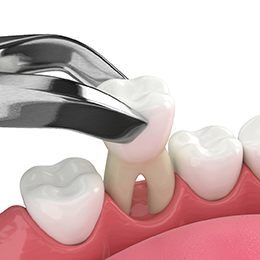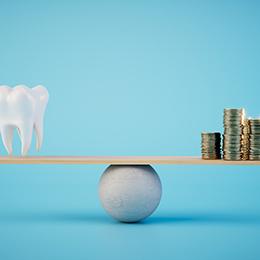Tooth Extractions – Nepean, ON
Your Oral Health Matters

When a tooth is severely damaged or decayed, Dr. Bal at Nepean Dental Centre will turn to one of our available restorative dentistry solutions first. Because it is the goal of our team to help you maintain your natural smile as long as possible, we’ll attempt to determine if a dental crown or root canal will be enough to fix the issue. If not, we’ll need to move forward with tooth extractions in Nepean to avoid damaging your oral health. Call our dental office if you would like additional information about the tooth extraction process and how to know if you need to have a tooth removed.
Why Choose Nepean Dental Centre for Tooth Extractions?
- State-of-the-Art Facility with Innovative Dental Technology
- Dentist with Decades of Experience and Training
- Putting Patients’ Comfort & Safety at the Forefront
Reasons Why Tooth Extractions Are Necessary

No one wants to have a tooth removed, but if it’s necessary to prevent your oral health from worsening, you can expect that our dental team will be here to walk you through the process step by step. But how do you know if extracting a tooth is absolutely necessary? Dr. Bal explains that if you suffer from one or more of the following problems, there is a good chance that you’ll need a tooth extraction:
- You require braces or a customized denture but need to have one or more teeth removed to ensure success
- You have a tooth that has suffered severe facial trauma and is no longer viable
- You’re dealing with severe decay that is posing a risk to nearby healthy teeth
- Your wisdom teeth are impacted or do not have enough space to fully erupt
- Your child’s baby teeth have yet to fall out
The Process of Removing a Tooth

There are two ways we can remove your tooth: a simple extraction and a surgical extraction. A simple extraction is ideal when the tooth that needs to be pulled has broken through the gumline. In this case, Dr. Bal can gently rock the tooth loose until it can be removed easily. A surgical extraction, on the other hand, is used when the tooth is trapped underneath the gumline. In this case, Dr. Bal will need to make a small incision in your gums first to access the tooth. The good news is that the first step is always the same in both simple and surgical extractions: numbing your mouth so you don’t feel any discomfort.
Tooth Extraction Aftercare

The healing period is extremely important, which is why we will provide you with specific instructions on what you should and shouldn’t do when you leave our office. A few examples include:
- Taking OTC pain medication as directed
- Avoiding physical activity, like weightlifting and running
- Using a cold compress for 10 minutes at a time
- Sticking to oatmeal, soup, scrambled eggs, and other soft foods
- Keeping your mouth and the extraction site clean
Understanding the Cost of Tooth Extractions

If you’ve just found out that you need to have a tooth extraction, it’s natural to have questions. One of the first things many patients want to know about is how much it costs. The answer depends on your unique circumstances, so you’ll need to schedule a consultation with Dr. Bal first. Then, we can provide more detailed information based on his findings. To read more about what influences the final amount due, continue reading below! If you have additional questions or are ready to schedule an appointment, please feel free to contact us and we’d be happy to accommodate you.
Factors That Can Affect Tooth Extraction Cost

We’re happy to give you an accurate estimate for your tooth extraction after your consultation. The pricing can be influenced by several variables including:
- The number of teeth requiring extraction. Each tooth being treated will accumulate additional costs due to the amount of work involved, anesthetics provided, etc.
- The location of the tooth. A molar can cost more to extract than a front tooth because it’s harder to reach and may require additional steps and equipment to remove.
- The complexity of the procedure. Surgical extractions cost more than simple extractions because of the added time, effort, and materials used.
- How the tooth will be replaced. There are different types of restorations like dental implants, bridges, or dentures that have varying expenses.
Does Dental Insurance Cover Tooth Extractions?

Many dental insurance plans reimburse 50% of the total cost of your tooth extraction once your deductible has been met. Some policies, however, include limitations so it’s important to familiarize yourself with the details of your plan. For example, you might only be able to treat a certain number of teeth or may need to complete a waiting period. Our friendly staff are familiar with many different policies and are happy to assist you with paperwork to maximize your benefits if you’re not sure what your plan covers.
How to Make Tooth Extractions Affordable

We believe that your budget shouldn’t keep you from getting the dental care that you need, and are happy to do what we can to make your tooth extraction more affordable. If you don’t have dental insurance, don’t lose hope! We proudly partner with DentalCard Financing to help break your payment into manageable monthly installments. We also offer a Student Discount program to young adults that saves you 20% of the cost of any preventative treatments. If you’d like assistance applying for either of these programs, feel free to contact our office to help with the paperwork.
Tooth Extractions FAQs
Does Getting a Tooth Extracted Hurt?
Whether it is a cosmetic dental service or a simple dental checkup and cleaning, many people tend to feel hesitant about undergoing dental treatment due to their fear of an uncomfortable process. The good news is that with modern dentistry, you can expect our team to provide sedation options to help lower your body’s ability to register pain as well as relax you during your appointment. Depending on the medication you choose, you might even feel like you’ve dozed off while getting the care you need. While the extraction procedure itself won’t hurt, you might expect mild soreness and discomfort sometime after your treatment. By adhering to our aftercare guidelines, you’ll help avoid infection while also minimizing swelling and encouraging proper healing. If you notice any issues or indications of infection (such as a fever), notify our team immediately for help.
What Should I Do After My Tooth Extraction?
Once you’ve returned home after your tooth extraction, the most important thing for you to do is to get plenty of rest. Doing so will promote better recovery following your procedure, but just make sure you keep your head elevated to avoid blood rushing to and disturbing the surgical site. Too much physical activity will be prohibited for the first 24 hours after your surgery. Be sure to place a gauze pad on the extraction site, drink plenty of water, and do not use a straw or spit. Eat soft foods that don’t require chewing, such as applesauce and mashed potatoes. Take over-the-counter/prescribed pain relievers and use a cold compress to alleviate discomfort while reducing swelling. Try your best NOT to touch the surgical site with either your fingers or tongue. Follow your dentist's aftercare instructions and you should expect a smooth recovery period.
Can I Leave the Space Empty After a Tooth Extraction?
Even if you’re getting a tooth removed from the back of your mouth that no one will notice, you’ll still need to consider a tooth replacement option. Aside from providing you with a dazzling smile, your pearly whites are also incredibly important for your ability to chew food properly as well as speaking clearly. Missing even a single tooth can cause certain complications with your bite, which can impact your diet or even increase the risk of malnutrition and indigestion. Most importantly, a lack of tooth roots can cause your jawbone to deteriorate or shrink, altering your facial structure and raising the chance for your remaining natural teeth to potentially shift out of place. To avoid this, you’ll need to speak with your dentist after you’ve recovered from your extraction procedure about tooth replacements, such as a dental bridge, denture, or dental implant.
What Can I Do to Speed Up the Healing Time?
Resting should be priority number one when it comes to your healing period. Avoid strenuous exercise for at least the first 24 hours and prop your head up while lying down, as having blood rush to your head can interfere with the blood clot forming around the surgical site. Make sure you have a gauze pad in place to promote proper healing and refrain from touching the area with your tongue or fingers. Remain hydrated and avoid using straws or spitting so that you can prevent dry socket, which can drastically delay your recovery.
